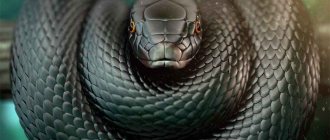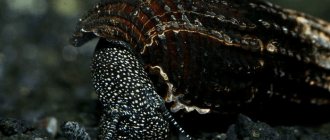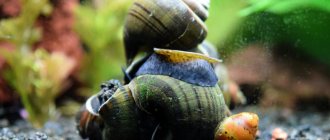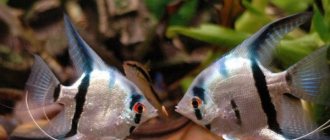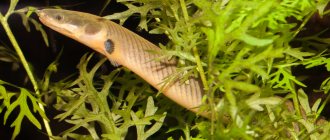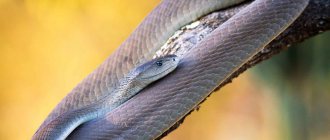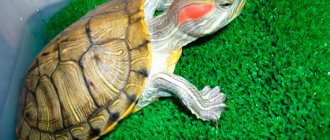Snakes belong to the order Scaly. But these are far from the only representatives of this detachment. It also includes lizards, monitor lizards and other reptiles. The snake has a characteristic structure: a spindle-shaped body, the head resembles an egg or a triangle, and there are no limbs. The body is completely covered with scales, which may differ from species to species. Many people are interested in one question: how do snakes mate?
Physiology of male and female
It is almost impossible to distinguish a male from a female by external signs.
The only external sign is that the females of most species are smaller than the males and are not as brightly colored. But for example, the female anaconda is larger than the male, so size is not an accurate sign for determining gender. The sexual characteristics of snakes are hidden inside the body. The male's paired fertilization organs, the hemipenises, are hidden in special pockets in the abdominal cavity, closer to the tail. In the presence of a female who is ready to mate, the hemipenes enlarge and become ready for mating.
It is noteworthy that only one of them is used during mating. But if there is another lady nearby, then there will definitely be an opportunity to use the second one.
Important! During the breeding season, snakes are most aggressive, and the female’s attraction of many males from throughout the surrounding area makes a chance encounter with reptiles even more dangerous.
The female's paired genital organs, the hemiclitors, are not visually visible and are located inside the body. The readiness of a female to mate is indicated by the pheromones she secretes. The male is able to sense them from a distance of several kilometers.
Mating snakes at home
Many novice snake lovers have an irresistible desire to get offspring from their pets. However, without certain knowledge and skills, mating snakes seems to be a difficult task. This article will tell novice breeders of these reptiles the basic rules, the implementation of which will help them succeed in properly maintaining their pets during the period of mating and the birth of snakes.
If the male and female are kept together, then, according to the unanimous opinion of experienced reptile breeders, they must be placed in different terrariums before mating, since forced separation greatly contributes to success. However, if the future parents are initially kept in isolation, or the producer is invited from the outside, then, on the contrary, they should be introduced before mating. In any case, this stage in snake reproduction should be taken extremely seriously.
Snakes reproduce sexually. In addition, among these reptiles there are oviparous and viviparous species. Although such a mixed type of reproduction of offspring as ovoviviparity is also not uncommon among snakes.
Conception
Mating of reptiles occurs in the spring, after the reptiles have crawled out of their winter shelter, warmed up in the sun and had a great lunch. The ladies emerge from the shelter later than the gentlemen, signaling their arrival with a specific smell.
Males attracted by pheromones try to drive other suitors away from the female and fertilize her. Male fighting looks like twisting opponents around each other, pushing the opponent out and trying to raise their head higher than the opponent is.
Rituals
In nature, during the mating season you can meet two snakes
We invite you to familiarize yourself with: Tambov geese and their contents
. They wrap their bodies around each other and sway rhythmically, looking at each other. This behavior is common, for example, among vipers. Each male tries to rise above the other. Intertwined, snakes can push each other, trying to knock over. Eventually, the intertwined bodies fall to the ground. It is not entirely clear how exactly the winner is determined, but one of the competitors crawls away. For other snakes, such a ritual occurs on the water. Usually the winner is the largest individual.
Snake Reproduction
After mating, the male’s functions end, and the female begins bearing offspring or forming a clutch. In the process of evolution, snakes have developed three methods of reproduction:
- live birth;
- eggs;
- cloning.
Viviparous are vipers, boas, anacondas, and rattlesnakes. After fertilization, the female carries the embryos for several months (1-2 months, very rarely - 3). At this time, the cubs receive nutrition through metabolic processes with the mother’s body, as well as substances from the yolk sac. Such babies are immediately born ready to get their own food and defend themselves from enemies.
Ovoviviparity
Ovoviviparous snakes give birth to live young, but they are formed in eggs inside the mother's body. The cub feeds on the yolk of the egg. Among terrestrial reptiles, tiger snakes, copperheads, and boa constrictors reproduce in this way. Marine species of snakes reproduce in the same way. The baby is born and hatches from the egg at the same time. This same unique method is shared with snakes by some species of marine fish.
Did you know? Snake sex is the longest lasting. It can last up to 10 days without a break.
70% of snakes are oviparous. These are taipans, cobras, mambas, grass snakes and other species. An important stage in raising offspring is the formation of a clutch. In warm countries with a tropical or subtropical climate, the female buries her eggs in a hole in the sand. Heating the sand by the sun guarantees the warming of the masonry. This is what the taipans do, for example.
This is where the mother’s participation in raising her offspring ends. The clutches of tropical snakes can take a very long time to heat up and mature - up to 9 months.
In countries with insufficient soil heat, the female lays the eggs in a hole in the grass and warms them with her body. The snake's muscles contract regularly, producing the heat needed by the clutch. Heat is also generated due to the rotting of organic matter (leaves and grass).
Important! Oviparous species, including vipers, choose compost heaps for laying, that is, places that already have rotting grass, to provide the cubs with the necessary level of warmth. You need to be very careful when interacting with such piles and any accumulations of grass in areas where snakes live.
Ovoviviparity and traditional clutches
it's a pile of rotting organic garbage. How do snakes give birth when creating a traditional clutch? It's simple: at the right moment, the female lays eggs. But after this, the snake does not leave its offspring, but is always somewhere nearby and guards the nest. When rotting occurs, heat is generated that warms the masonry. Also, many types of snakes specifically bask in the sun in order to then transfer the accumulated heat to their eggs.
If the incubation period is short, which occurs in some species, the cubs can hatch from the shell while still in the mother’s body. How do snakes give birth in this case? This method of producing offspring is called ovoviviparity.
We invite you to read: How do snakes give birth to their offspring? How can snakes both give birth and lay eggs? Are snakes viviparous or not?
Caring for offspring
Snakes of temperate latitudes are always close to their clutches, even at the time of hunting. Therefore, we can say that care for offspring appears only in those species that help warm the clutch. Reptiles are very sensitive to temperature changes. When the heat in the clutch decreases, the mother additionally warms it by contracting her muscles.
The female regularly carefully examines the clutch and is ready to help the cub emerge from the egg. Although in most cases the baby snake chooses itself, using a special egg tooth, with which it breaks the shell. The hatched baby can remain in the egg for some time, quieting down at the slightest suspicious noise. But as soon as it emerges from the egg, it is considered independent, and the mother’s care for it ceases.
Did you know? Despite the fact that most species lay quite a lot of eggs or give birth to more than 50 young, only a fraction of them reach maturity (about 10%). Most of the young animals die for a variety of reasons.
Females of viviparous species consider their mission accomplished as soon as the baby is born. Representatives of poisonous species are equipped with a fully capable poison and can kill prey immediately after birth. As the baby grows, the size of its prey will increase.
Structure
It has a distinctively large number of vertebrae, the number of which reaches 450. The sternum and rib cage are absent; when swallowing food, the snake’s ribs move apart.
The bones of the skull are movable relative to each other. The two halves of the lower jaw are elastically connected. The system of articulated bones allows the mouth to open very wide in order to swallow fairly large prey whole. Snakes often swallow their prey, which can be several times the thickness of the snake's body.
The teeth are very thin and sharp. Poisonous individuals have large and backward-curved poisonous fangs on the upper jaw. In such teeth there is a channel through which, when bitten, poison enters the victim’s body. In some poisonous snakes, such teeth reach a length of 5 cm.
Internal organs
They have an elongated shape and are asymmetrical. In most individuals, the right lung is more developed or the left is completely absent. Some snakes have a tracheal lung.
The heart is located in the cardiac sac. There is no diaphragm, which allows the heart to move freely, avoiding possible damage.
The spleen and gallbladder perform the function of filtering blood. There are no lymph nodes.
The esophagus is very powerful, which makes it easy to push food into the stomach and then into the short intestine.
Females have an egg chamber that acts as an incubator. It maintains the level of moisture in the eggs and ensures gas exchange in the embryo.
Feelings
To distinguish odors, a forked tongue is used, which transmits odors to the oral cavity for analysis. The tongue constantly moves, sampling particles of the environment for testing. In this way, the snake can detect prey and determine its location. In water snakes, the tongue picks up odor particles even in water.
The main purpose of vision is to distinguish movement. Although some individuals have the ability to obtain a sharp image and see perfectly in the dark.
- Thermal and vibration sensitivity
The organ of heat sensitivity is very developed. Snakes can detect the heat that mammals emit. Some individuals have thermolocators that determine the direction of the heat source.
Earth vibration and sounds are distinguished within a narrow range of frequencies. Parts of the body in contact with the surface have increased sensitivity to vibration. This is another ability that helps when tracking down prey or warning the snake of danger.
Breeding frequency
Sexual maturity of snakes occurs at 2–3 years. For pythons, this period increases and they will become adults by 4–5 years. Reproduction of most species living in areas with changing seasons occurs once a year, in the spring, after hibernation.
In a tropical region, where the air temperature is constant throughout the year, mating can occur year-round. The basis for starting it is the availability of a sufficient food supply.
We suggest you familiarize yourself with: How to wash cat marks, an effective means for removing odor and marks
The methods of reproduction of snakes, as well as the timing, are more diverse than the methods of reproduction of mammals. All of them appeared in the process of evolution and have been preserved in all their natural diversity to this day.
What to do if a dog is bitten by a viper?
The common viper weighs on average 100 g, the maximum weight is about 200 g. The average length is 65 cm. But on the Scandinavian Peninsula there are individuals up to 90 cm in length. The color is very diverse, it can be yellow, gray, or black, brown. A distinctive feature of the viper is its flat head, which is clearly separated from the body by the cervical region.
In this case, there are three shields on the head. The nose is located on the middle shield. The eyes have an interesting and unusual vertical shape, which gives the snake an evil appearance. Found in Europe and Asia. Unlike its relatives of the snake family, the common viper prefers lower temperatures, so it is found even in the northern zone.
Common viper
Indeed, the venom of the common viper is not much different from its tropical relatives and those that live in Europe and Asia. It has a mainly paralytic effect and is a strong allergen. However, it rarely leads to death. This is mainly observed if a person has a severe allergic reaction to some medications, and in particular to viper venom.
Danger to humans
If you know a few differences between a viper and a grass snake, a snake and a copperhead, then recognizing these snakes is not difficult at all. There are a number of characteristics and distinctive features.
Differences and similarities:
- First of all, snakes can be distinguished by the shape of their head: in the viper it is slightly oval, flattened, more like a triangular one. In the snake it is oval, egg-shaped.
- The viper has a clear transition from the neck to the body. The snake does not have such a transition; it is somewhat smoothed out. You can also distinguish them by color. The viper has zigzag stripes on its back; the grass snake does not have such stripes. He's all spotted
- The copperhead has yellow spots that are arranged in a checkerboard pattern. If we compare the color of the abdomen, then the viper’s abdomen is almost always gray or black. The grass snake has transitions. Closer to the head the color is variegated, and towards the tail it is a little darker.
- They can also be distinguished by the shape of the body. The viper has a much shorter body, the tail is not so sharp, much more blunt. The snake has a thinner body and a sharp tail. You can also distinguish by the pupils. In the viper they are vertical, in the grass snake, copperhead and snake they are ordinary - round.
- If you look at more than just the eyes, and you have the opportunity to pick up the snake, you can press the jaws from the side and look at the teeth. The viper has two huge incisors. It is from these teeth that the poison is released. Snakes don't have such teeth. All his teeth are the same size, there are no incisor-like teeth.
- You can identify a snake by its habitat. If you have seen a snake in the water that is catching fish, it is most likely not a viper, but a viper. Because vipers rarely catch fish.
- If you see a snake on a tree, it is also not a viper. Because she doesn’t like crawling through trees either.
- If you are walking along the landing and see a whole tangle of snakes, this is also not a viper. Because they mate in pairs and do not curl up into balls.
- If you see eggs on the road, these are also not viper eggs. These snakes are viviparous, but they lay eggs.
Common viper
- Pit vipers. They are called rattlesnakes or rattlesnakes (lat. Crotalinae). They are distinguished by the presence of 2 infrared pits, which are located in the recess between the eyes and nostrils.
- Toad vipers. They belong to the oviparous type of snakes, which is rare among all members of the family.
- Vipers (lat. Viperinae). The most numerous subfamily, whose representatives live even in the Arctic (common viper).
- Azemiopinae. A subfamily represented by a single genus and species is the Burmese fairy viper.
Toad vipers
You can find a lot of advice that says that when bitten by a viper, you need to suck out the poison from the wound. In fact, this is an absolutely useless procedure, because the poison spreads instantly. In addition, there is a risk of introducing bacteria from the mouth into the wound. In some sources you can find recommendations to apply a tourniquet over the bite site.
Recommendations:
- It is necessary to take antihistamines with you when going to the forest. This could be Diazolin, Cetrin, Claritin or Eden. A sedative will also come in handy.
- In most cases, if severe swelling has not developed 15 minutes after the viper bite, there is no anaphylactic shock; most likely, the pain at the site of the bite will go away in a few days without significant consequences for the body.
- If the reaction to the bite is serious, there is swelling of the larynx or face, then you need to urgently go to the emergency department. There you will be injected with serum. Systematic treatment is also carried out, which is aimed at eliminating the consequences of the bite.
- That is, if the bite provoked a drop in pressure, it is increased, antihistamines are given, and adrenaline can be administered.
- Therapy for dogs is the same as for people. It is necessary to give an antihistamine and, if necessary, administer anti-venom serum. But as practice shows, breeds such as hunting dogs and dachshunds, which are usually taken with them on hunts, tolerate viper bites well without consequences for the body.
- After about a week the animal will feel well.
We suggest you read: Angelfish breeding at home
Help with a viper bite
Bite symptoms:
- Acute pain
- Numbness at the site of the bite
- After this, as the poison spreads, you may experience dizziness
- Anaphylactic shock
- Edema
- Strong pain
- Redness at the site of the bite
It all depends on how much a person reacts to the snake’s venom. There are cases when after almost 15 minutes the symptoms of the bite disappeared. But in some cases, a viper bite can lead to death. It is necessary to observe the person in the first 15-30 minutes after the bite. If he experiences severe swelling of the face or larynx, he should urgently consult a doctor. You urgently need to go by taxi or ambulance to the hospital to administer serum and antihistamines.
The first aid is to take antihistamines, these are Diazolin, Claritin, Eden or Loratadine. You can also take Diphenhydramine. You can take analgesics and painkillers. If it is a child, you need to go to the hospital immediately. It is not recommended to suck out the poison from the wound or apply a tourniquet.
If a viper bites a dog, the measures are the same as for a human bite. It is necessary to administer an antihistamine and pain reliever to the animal. Let him rest; the ideal option would be immobilization.
Viper venom has a different effect on each person. Some recover quickly, while others take a very long time to recover. Recovery may take up to a year if appropriate measures are not taken. The ideal option would be to go to the hospital immediately after the bite, without waiting for swelling or any consequences. In this case, the toxicology department administers Prednisolone, an antihistamine, and also makes several cleansing droppers.
If necessary, a special serum is administered. After a bite, severe swelling may occur, as well as bruising that does not appear on the day of the bite. They may occur for another week or even 10 days. Cases have been recorded that, due to swelling after a viper bite, the skin on the limbs burst due to the fact that it could not withstand strong stretching.
Be prepared that after a viper bite you will have to spend several days in the hospital, because doctors monitor the patient’s condition and try to reduce pain. At home, you will not be able to quickly and effectively remove poison from the body. The most dangerous viper venom is for allergy sufferers and people with heart disease.
Snake bite
The serum is usually found in large hospitals as well as in large population centers. Unfortunately, in villages or some paramedic stations in villages, such a tool may not be available. A similar substance can be purchased at some large pharmacies, as well as in online stores. If you are in the capital, then courier delivery of this drug can be carried out.
We do not recommend administering the serum yourself; we insist on going to the hospital. There is usually only one serum that is administered, and it is called “serum against the venom of the common viper.” It is produced in special factories using horse blood. Antibodies found in this serum neutralize the effect of viper venom.
Viper bite serum
In general, snakes rarely rush at people on their own, but if you see that a viper has noticed you and curled up in a ring, it is going to rush at you. The ideal option would be to have a stick in your hands. It needs to be placed in front so that the snake bites the stick. Do not suddenly run away or rush at the snake. It is better to freeze and stand in a motionless position; most likely the snake will understand that you are not dangerous and will crawl away.
Viper curled up in a ring
If you find a sand viper, then under no circumstances should you initially attack it. There is no need to try to grab the tail, head or rush at it. Just freeze, and if possible, take a long stick and just hit the ground. You can loudly hit the ground with a stone or boot, or throw some kind of log.
general information
Snakes are divided into males and females. This trait is common to all reptiles. The following types of reproduction are common among snakes:
- Laying eggs. After fertilization, the female lays eggs.
- Viviparity. After fertilization, the eggs do not leave the female, but remain inside. They are penetrated by the mother's blood vessels. Gas exchange will take place through them. The food is the yolk found in the egg. Many vipers are viviparous.
- Ovoviviparity. Fertilized eggs remain inside the female's body in a special section of the oviduct. The hatched snakes leave the female's body. Some species of vipers and all boa constrictors are an excellent example of ovoviviparity.
In the first case, the eggs are covered with a shell resembling skin. Fertilization occurs in the female's body. It is called internal. But how does a snake mate to prolong its lineage?
Do vipers live, and which ones are found in Belarus, the Urals, Siberia, Tatarstan, the Caucasus, or live in the steppe?
The viper lives in the Caucasus, in the steppes, in the mountains, and also in the northern latitudes. Tolerates heat and cold well. Therefore, the common viper can be found almost everywhere. As for their habitat, they burrow deep into the ground for the winter. During the day they often hide in burrows. Because they prefer to hunt at night and do not like being around other snakes.
The viper's diet differs significantly depending on the region where it lives, as well as the time of year. We can say that the basis of its diet are frogs, small birds, mice, rodents, and lizards. Young snakes that have recently hatched from eggs feed primarily on insects. These are earthworms, beetles, slugs.
Steppe viper
It is worth noting that this species is distributed almost throughout the globe, except for Australia and some northern regions.
Habitat and species:
- So-called steppe vipers are found in Kazakhstan.
- In the Caucasus there are steppe vipers, the viper, the common viper, and the real viper.
- Recently, a whole invasion of vipers has been recorded in the Urals. A large number of people suffer from them. The common viper is mainly common here.
- This species is also found in Siberia, Tatarstan, and also in Belarus. The steppe viper has become widespread in Belarus.
Steppe viper
Vipers should not be completely destroyed, because this may damage the natural balance. The fact is that these reptiles eat rodents and mice, which harm crops, and are also very undesirable in summer cottages. In addition, they eat a large number of insects, slugs, worms that eat the roots of plants, as well as garden crops.
Therefore, if there is a viper in your summer cottage, do not rush to kill it. It is best to bring a hedgehog to the site and feed it often. Vipers are afraid of hedgehogs, so they try in every possible way to change the trajectory of their movement, and also change their places of residence.
We invite you to familiarize yourself with: Caring for a French bulldog, puppy and adult, photos and videos
Viper
How snakes are born - the birth of snakes
Long body, no limbs. Snakes are distinguished from legless lizards by their movable jaws, which allow them to swallow food whole. Snakes also lack a shoulder girdle.
The entire body of the snake is covered with scales. On the side of the abdomen, the skin is slightly different - it is adapted for better traction with the surface, which makes it much easier for the snake to move.
Molting (change of skin) occurs in snakes several times a year throughout their lives. It changes in one moment and in one layer. Before molting, the snake looks for a hidden place. The snake's vision becomes very cloudy during this period. The old skin bursts in the mouth area and separates from the new layer. After a few days, the snake's vision is restored and it crawls out of its old scales.
Snake shedding is very beneficial for a number of reasons:
- Old skin cells change;
- This is how the snake gets rid of skin parasites (for example, mites);
- Snake skin is used by humans in medicine to create artificial implants.
Snake Reproduction
Before talking about how reptiles are born, it is more appropriate to understand the process of reproduction itself. Snakes have paired genitalia, the female has a cloaca, and the male has a hemipenis. When mating, two individuals intertwine their tails. At this moment, the male's hemipenis enters the female's cloaca and ejaculation occurs.
What happens in the natural environment, how do snakes give birth? On a tree, on the ground, or even in burrows and hollows - this is where the offspring are born.
It takes the young animals some time to get stronger and get used to the world that is new to them.
And the mother instinctively strives to give birth to her offspring where they are most protected from the negative effects of the environment and various enemies.
The photo shows how snakes reproduce. This process looks really nice. In most cases, snakes are heterosexual creatures. Although it happens that among these animals there are hermaphrodites.
Since the reproduction of snakes is heterosexual, a male and a female are involved in this process. An untrained person cannot distinguish one animal from another. After all, they hardly differ in external features.
Sometimes it may be that the female is smaller in size. But this only happens in certain species. In most cases, snakes are all the same in appearance.
Sometimes males still have a flat tail. As stated earlier, the temperature must be comfortable enough for snakes to breed successfully.
Most often this happens in the spring, when it is not too hot, but not too cold.
If snakes live in the desert, then they reproduce when conditions are favorable, and this is not always spring. After all, this area is characterized by its extreme survival conditions, in which it is not always possible for an individual animal to exist favorably. And what about reproduction? In general, this function is killed first of all when the situation is in the pessimum zone.
In ecology there is such a thing as an optimum zone. These are the conditions that are ideal for a certain biological species to live as a whole, a single population or individual. Everything that is not included in the optimum zone is called the pessimum zone. These critical conditions do not always have a bad effect on the animal's body.
Let's just say that they sometimes have an adverse effect, but at the same time the animal can adapt to environmental conditions. And then all lost functions will be restored again. Approximately the same thing happened with snakes living in deserts. And this confirms that photos of snakes that breed in deserts are truly beautiful.
Naturally, you should not have a snake that will crawl around the room to scare people. But you can equip a terrarium. Recently, this form of keeping pets in your home has become increasingly popular.
The reason for this is that snakes are unpretentious, they do not need to be walked, they lead a mostly passive lifestyle.
The biggest problem associated with breeding snakes at home is the need to create a beautiful and comfortable terrarium.
Photos of such terrariums can be easily found on the Internet. Here are some more pictures of some really nice terrariums that are good for snakes. Snakes are unique living creatures when it comes to caring for them. For the most part, they only need to be fed. Why not buy a terrarium so that you can enjoy snakes not only in photos, but also in real life?
How snakes reproduce: photo
Snakes reproduce by laying eggs or giving birth to young. Most colubrids, slates and pythons are oviparous. And most of the vipers, sea snakes and pit viper species are ovoviviparous.
Ovoviviparity (as opposed to natural viviparity) is more typical for mammals. This process involves the birth of live young that developed in the mother's body in the egg shell (that is, snakes carry eggs inside the body), without being connected to the parent body through blood vessels
In nature, there is a smooth transition between ovoviviparous and oviparous. One of them is characterized by laying eggs already in the first stages of development; others develop embryos; still others give birth to babies that are ready to emerge from the eggs, while others give birth to snakes that emerge from the eggs in the mother’s body.
Ovoviviparity is caused by the urgent need to preserve the clutch inside the body in the event of unfavorable conditions (otherwise the clutch would die). For this reason, ovoviviparity is characteristic of sea snakes.
In addition, other snakes lay eggs in the same way - keeping them inside the body.
This is also typical for species living in mountainous regions, high latitudes - wherever the temperature is not high enough for the normal development of eggs.
Recent studies have shown that the oviduct of snakes consists of four sections: the uterus, the egg chamber, the albumen and the funnel. The histological structure of the protein section of the oviduct resembles a similar section of the avian oviduct, but it is much shorter in length. The eggs are stored in the front chamber for a very long period.
The egg chamber plays the role of an incubator during this period. Its task is to supply moisture to the egg and ensure gas exchange in the embryo. That is, when laying eggs (as well as during ovoviviparity), physiological contact occurs between the embryo and the maternal body.
The eggs are covered with a soft, leathery shell. Snakes bury them in leaves, manure or soft soil - where there is a suitable temperature regime. This is also an important stage that helps to understand how snakes lay eggs.
It is noteworthy that after this, most of the snakes actually do not participate in caring for the clutch. But there are certain species that can guard laid eggs (this is typical for the American mud snake, mountain keffiyeh, and king cobra).
Pythons, in addition, are able to “incubate” the clutch: the female python wraps her body around it, the temperature of which rises by 10-15 degrees (compared to the ambient temperature). This guarantees the normal development of eggs.
In addition to ovoviviparous species, there are species of snakes endowed with the rudiments of true viviparity (magnificent denisons, North American garter snakes, vipers and most sea snakes).
The embryo, which is in the egg, has a connection with the mother’s body. This connection is carried out through a network of very thin blood vessels - all this provides it with additional nutrition.
Such a formation can be compared with a primitive placenta.
Structure
It has a distinctively large number of vertebrae, the number of which reaches 450. The sternum and rib cage are absent; when swallowing food, the snake’s ribs move apart.
The bones of the skull are movable relative to each other. The two halves of the lower jaw are elastically connected. The system of articulated bones allows the mouth to open very wide in order to swallow fairly large prey whole. Snakes often swallow their prey, which can be several times the thickness of the snake's body.
The teeth are very thin and sharp. Poisonous individuals have large and backward-curved poisonous fangs on the upper jaw. In such teeth there is a channel through which, when bitten, poison enters the victim’s body. In some poisonous snakes, such teeth reach a length of 5 cm.
Internal organs
They have an elongated shape and are asymmetrical. In most individuals, the right lung is more developed or the left is completely absent. Some snakes have a tracheal lung.
The heart is located in the cardiac sac. There is no diaphragm, which allows the heart to move freely, avoiding possible damage.
The spleen and gallbladder perform the function of filtering blood. There are no lymph nodes.
The esophagus is very powerful, which makes it easy to push food into the stomach and then into the short intestine.
Females have an egg chamber that acts as an incubator. It maintains the level of moisture in the eggs and ensures gas exchange in the embryo.
Feelings
To distinguish odors, a forked tongue is used, which transmits odors to the oral cavity for analysis. The tongue constantly moves, sampling particles of the environment for testing. In this way, the snake can detect prey and determine its location. In water snakes, the tongue picks up odor particles even in water.
The main purpose of vision is to distinguish movement. Although some individuals have the ability to obtain a sharp image and see perfectly in the dark.
- Thermal and vibration sensitivity
The organ of heat sensitivity is very developed. Snakes can detect the heat that mammals emit. Some individuals have thermolocators that determine the direction of the heat source.
Earth vibration and sounds are distinguished within a narrow range of frequencies. Parts of the body in contact with the surface have increased sensitivity to vibration. This is another ability that helps when tracking down prey or warning the snake of danger.
Ovoviviparity and traditional clutches
it's a pile of rotting organic garbage. How do snakes give birth when creating a traditional clutch? It's simple: at the right moment, the female lays eggs.
But after this, the snake does not leave its offspring, but is always somewhere nearby and guards the nest. When rotting occurs, heat is generated that warms the masonry.
Also, many types of snakes specifically bask in the sun in order to then transfer the accumulated heat to their eggs.
If the incubation period is short, which occurs in some species, the cubs can hatch from the shell while still in the mother’s body. How do snakes give birth in this case? This method of producing offspring is called ovoviviparity.
Lifestyle
Snakes are common almost everywhere, with the exception of Antarctica. They predominate in tropical climates: Asia, Africa, Australia and South America.
A hot climate is preferable for snakes, but the conditions can be different - forests, steppes, deserts and mountains.
Most individuals live on land, but some have also mastered the water space. They can live both underground and in trees.
When cold weather sets in, they hibernate.
Nutrition
Snakes are predators. They feed on a variety of animals. Both small and large. Some species have a preference for only one type of food. For example, bird eggs or crayfish.
Non-venomous individuals swallow prey alive or suffocate it before eating. Venomous snakes use venom to kill.
Are there viviparous snakes?
Some reptiles seem to have borrowed the process of bearing offspring from mammals. These snakes do not lay eggs. The cubs develop in the mother's body, receiving nutrition through a simple placenta. When the offspring is ready to begin an independent life, it is born. Now you know how snakes give birth.
Photos of this process are fascinating and at the same time endlessly surprising. Meanwhile, viviparous species include the American garter snake and the well-known common viper.
Almost all species of sea snakes do not lay eggs. These reptiles have a very strongly developed instinct of self-preservation.
Snakes carefully take care of their offspring; their nests are never arranged chaotically, although they look that way.
When planning to lay eggs or give birth to cubs, the female carefully chooses a secluded place. A similar picture can be seen in any terrarium. Before giving birth, the female will definitely hide in a shelter or build a nest.
Let's just say that snakes are no longer viviparous, but ovoviviparous. To explain the principles of this type of birth of a child, it is necessary to describe the process of embryo maturation itself. From the very beginning it always matures in the parent. After this, eggs may be born, which will further develop in the external environment.
Ovoviviparity is characterized by the development of an egg inside the female, and after this process reaches its peak, a snake will be born, which hatches from the egg in the mother’s body. At this time, the egg itself comes out. Moreover, such animals remain independent from the moment they are born.
However, truly viviparous snakes also occur. As a rule, these are boas or vipers that live near bodies of water. In this case, their child, in the early stages of its development, is nourished from its parents through the placenta using a complex system of interconnected blood vessels.
That is, snakes reproduce in all three ways:
- egg laying;
- ovoviviparity;
- viviparity.
Do you care about your pet's health? We are responsible for those we have tamed!
“- says a quote from the story “The Little Prince”. Maintaining the health of a pet is one of the main responsibilities of the owner. Take care of your pet by giving him a complex. The unique complex is designed for cats and dogs, as well as birds and rodents. This active supplement will help your pet shine with health and share happiness with you!
Source: https://boerboels-kennel.ru/razbiraemsya-rozhdayutsya-zmei/
How do vipers behave in nature, how do they winter, and how long do they live?
Crossbreeding between a snake and a viper is unlikely, because vipers are viviparous, and snakes lay eggs. This makes a significant difference. In addition, these are different species, they have different structures of the genital organs. There is a popular belief that there are poisonous snakes, as well as vipers that swim in reservoirs and catch fish.
In fact, these are fictions. People often confuse vipers with water snakes, which do not have the typical colors of snakes. Most often they are of a dark, uniform color, but upon closer examination it is clear that his pupils are not vertical, but ordinary round. When eating fish and swallowing it, there are no these large sharp incisors.
Vipers lead a terrestrial lifestyle, although among their relatives there is such a species as the earthen viper, which prefers to burrow underground and hide in holes. It can also live in crevices between rocks or under stones. Basically, all types of vipers lead a sedentary lifestyle and do not really like to move long distances.
It has been established that during hibernation, a viper can burrow underground to a depth of 1 m. Because it is impossible to freeze at such a depth. The reptiles come to life in mid-spring, around the end of April. They can also overwinter in rodent burrows or under tree roots.
On average, a viper can live 15-30 years, but some observations by scientists prove that the survival period is significantly reduced after two or three years of reproduction. That is, childbirth significantly reduces the life expectancy of vipers. The average age of giving birth reaches 5-7 years.
Viper
If you live in a private house and a snake was spotted on your property, then you need to try to protect your home from the viper’s entry.
Ways to fight:
- We recommend removing all piles of rubbish, as well as stones, and cutting the grass. Place mothballs around the house; this smell repels snakes.
- It is also worth using regular sulfur, which can be purchased at the pharmacy. Using gloves, you need to scatter sulfur around the house, as well as at the entrance to it.
- These methods are not suitable if you have small children or pets who may eat the poison.
- If you think there is a viper living in the basement, you will need to seal all openings that lead into the house. Use foam or other sealant.
- When you find a snake nest, it is best to call a professional to help control the animals.
- Under no circumstances should you grab or try to kill a viper; purchase special traps for snakes.
Viper in the house
Breeding snakes in captivity
Reptiles are increasingly found as pets. This is mainly due to ease of maintenance. There is no need to walk with a snake; they rarely feed and behave mostly passively. The main thing is to choose the right terrarium and follow the recommendations of a specialist in terms of climate.
It is rare to observe how snakes reproduce in captivity, since this happens only under a favorable combination of several circumstances. Firstly, there should be 2 of them, and of different sexes. Hermaphrodite species are not kept at home. People mainly buy boas or snakes. Some of them live in trees in the wild. Therefore, for a comfortable stay in captivity, in addition to suitable temperature and humidity, it is necessary to create an imitation of the trunk, roots, and spread pieces of bark. You can see how snakes reproduce in a terrarium only if they are absolutely comfortable. Before the planned mating season, it is better to resettle the couple and keep them separate for several days, lowering the temperature slightly. In this way, hibernation in natural conditions is simulated. Then they are placed in a common terrarium, the temperature is increased and they wait for the result.
How does a viper reproduce? Does it lay eggs or is it viviparous?
It is worth noting that vipers are viviparous. They don't lay eggs. The process itself is something between the birth of a child in humans and the laying of eggs in a chicken, because the viper gives birth to an egg in a soft shell, which develops during the birth process. At one time, a viper can give birth to 5-12 cubs.
Basically, the birthing process takes place on a tree: the snake swings its lower body to the sides, the snakes fly apart and fall on the grass. The most interesting thing is that inside the mother, the fetuses feed not only on the yolk, which is in the egg, they are connected to the mother’s body. We can say that they feed through the placenta. The viper does not show any care for its babies; immediately after birth, they crawl to the sides.
Mating begins 14-21 days after awakening. During this time, the snake eats its food, gains strength and mates. The fact is that vipers can accumulate sperm inside the body and fertilization occurs when it is convenient for the snake. That is, they have special sperm receptacles in which it can be stored for quite a long time. In one terrarium, the maximum period was recorded: only 6 years after mating, the viper gave birth to cubs.
Viper genera
Viviparous species
Regardless of how snakes reproduce, their embryos almost always develop inside the egg, feeding on its environment. In most cases this occurs in a nest or other hiding place. But sometimes the cubs develop directly inside the female and are born while simultaneously hatching from the eggs. Moreover, they are completely independent from the first days of life.
Viviparous snakes in the classical sense are also found in nature. These mainly include inhabitants of reservoirs, as well as some boas and vipers. In this case, the embryo breathes and feeds through a single circulatory system with the mother.
Rules of conduct when meeting a viper
Behavior rules:
- Snakes themselves are not aggressive and do not attack a person first, so it is necessary, as soon as you notice a snake, to move away from this place.
- If the viper has taken a defensive position, hisses, opens its mouth wide, there is no need to move, make any sudden movements, or run away.
- Also, don't try to grab her by the tail or head. A good option would be to use a stick.
- Take some kind of long stick, hold it in front of you, perhaps the viper will attack it. Then you can escape from this place.
- It is worth remembering that the viper does not know how to crawl quickly, so it will not be able to catch up with you, but you should not run away when the snake is in the hissing and defense phase.
- Knowledgeable people note that a snake that you did not notice is more dangerous than the one that you saw.
Viper

